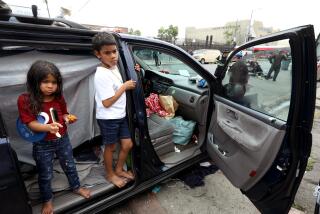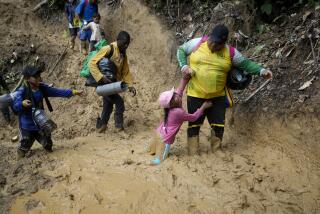Homeless Children Live in Rail Station : Poverty: Some of Calcutta’s destitute youngsters stay in a train depot and even attended school there for a time. Aid programs cannot keep pace with the influx of poor people.
- Share via
CALCUTTA, India — Howrah railway station is a blur of motion and noise, a corridor for 900,000 passengers a day. It also is home for dozens of families and hundreds of children.
One day last June, 40 of the children who sleep, work, play, beg and sometimes steal in the huge, red-brick station gathered in a circle on the concrete floor. As commuters stared in astonishment, they had their first day of school.
Two months later, the class moved across the road, behind the vegetable market, to an illegally built one-room shack with thatched walls and a sagging, red-tile roof.
There, sitting on the floor with small chalkboards on their laps, homeless kids ages 5 to 13 are beginning a long climb toward a better life.
The syllabus is basic: reading, arithmetic, hygiene.
“If I study, maybe I can get a real job,” said Morjina Khatun, 12, who spends most of the day selling lemons from a wicker basket on the steps of the railway station.
If she works hard, Morjina can sell 1,000 lemons a day for a profit of 40 rupees, or about $1.50.
The woman she calls Grandmother--probably no relation--objects to Morjina’s going to the class because the three hours of schooling each day cuts into the family income.
Morjina never went to school before. Her mother died when she was an infant. Her father remains in his village, farming land that cannot support a large family.
Asked where she lives now, she replies: “Platform 8.”
After eight months, she reads and writes Bengali and has learned the English alphabet. Beyond gaining functional literacy, Morjina is given a few hours off from the adult world she lives in.
“Over these months, we have watched their expressions change from disinterest and disillusionment,” said Aloka Mitra, a social worker who started the project. “Their faces have softened. They became the children that they are, full of fun and happiness.”
The Howrah Station school is a shoestring operation of the Women’s Coordinating Council, which runs institutions for street children. The teachers are young volunteers.
Dozens, perhaps hundreds, of self-help programs brighten an otherwise bleak future for the homeless of Calcutta, but hardly make a dent in the needs of the thousands of ragged street children.
Howrah Station was the gateway to the capital of British India, the Asian hub of the vast British Empire. Now it is on the edge of one of the world’s worst slums. Shanties are clustered around the Victorian terminal where the rich and royalty once stepped from posh coaches.
Calcutta is a decaying city of open sewers and overflowing garbage, of millions of slum dwellers and an estimated 400,000 homeless people who must struggle daily for survival.
The city overflows with migrants from the countryside and refugees from the recurring disasters in Bangladesh. The population doubled in 30 years to 11 million, outpacing the government’s ability to house or educate its citizens.
A recent survey estimated that Calcutta has 56,000 homeless children under 18, more than half of them between 6 and 10.
One in three works. Some, such as Morjina, sell goods and others work in shops or garages. About 8% are household helpers; 9.3% are classified as beggars.
About 80% of these children eat two meals a day, but few get enough protein or vitamins, said the report from the Institute of Psychological and Educational Research, which conducted the survey.
More to Read
Sign up for Essential California
The most important California stories and recommendations in your inbox every morning.
You may occasionally receive promotional content from the Los Angeles Times.













